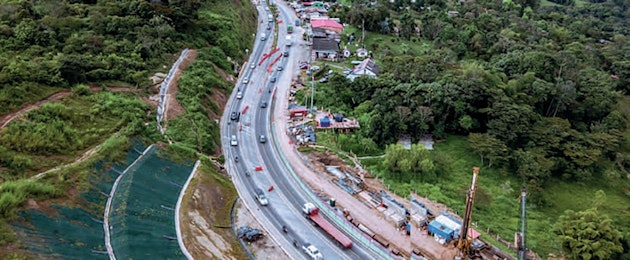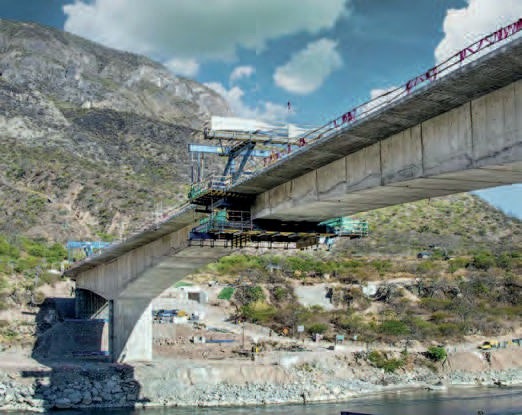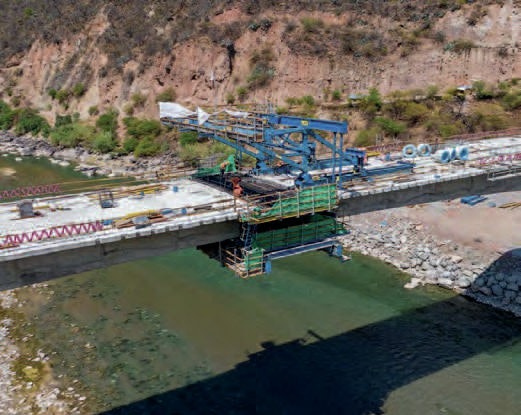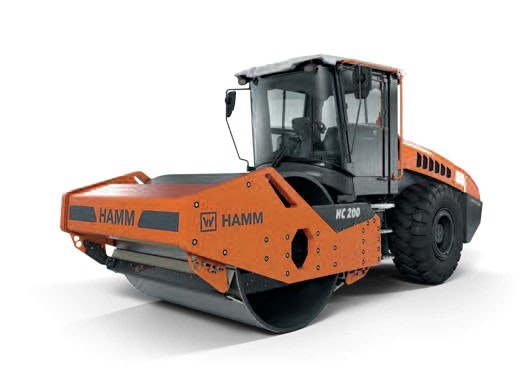INDIA TO BUILD 37 NEW ROADS ALONG ITS CHINA BORDER
Caterpillar has added the RM600 and RM800 reclaimer/stabilizers to its product line, machines that can efficiently complete soil stabilization and full-depth reclamation projects. The machines are equipped with an all-new adjustable height design that can perform cross-slope cutting. Additionally, the Cat C18 engine is said to provide the RM600 with up to 17% more power than the RM500B, while the RM800 delivers up to 42% more power than the RM500B and up to 23% more power than the RM600. The reclaimer/stabilizer models incorporate key rotor system components from Cat cold planers for reliable cutting and mixing. The machine can flush-cut on the right side with a belt-driven rotor drive system. Cat adds that the standard electronically controlled all-wheel drive maximises traction and mobility, while four height adjustable legs provide up to + or - 12.5% (8 degrees) of slope on either side when working on uneven terrain or to maintain traction in challenging soil stabilisation applications.
FLUOR’S NEW APPROACH TO ROAD PROJECT
US$1 BILLION ROAD PROJECT FOR SKANSKA

The new 1km-long Francisco Morazán viaduct
PHOTO: MINISTERIOS DE OBRAS PUBLICAS VIA TWITTER
The construction of roads requires careful planning, advanced engineering, and significant financial investment. Aligned to this, the industry continues to take on the task of bringing new and innovative ways to build and pave roads, as well as construct them in challenging conditions.
Under the India-China Border Roads (ICBR-III) program, the Union government plans to construct 37 additional roads totalling 875 kilometres along the India-China border at an estimated cost of Rs 130 billion (US$1.5 billion). The ongoing phases of the ICBR, which aims to construct 1,435km of roads across Ladakh, Himachal Pradesh, Uttarakhand, Sikkim, and Arunachal Pradesh, are estimated to cost Rs 16 billion (US$195 million). Following a crucial meeting to address the issues that were causing delays in the first two phases of the project, the ICBR-III program has been launched. The proposal prioritises the development of 22 roads that have already been started under ICBR-III. However, the starting points for the remaining sections of the roads will not be available until the ongoing projects have been completed.

US-based contractor Fluor and its Dutch joint venture (JV) partner Ballast Nedam have been awarded a contract to design, build and maintain a major section of the A27 motorway in the Netherlands. Fluor’s share of the contract will total €414 million (US$457 million). The JV team will extend approximately 40km of the existing motorway to form a future connection to the proposed Groote Haar business park in Gorinchem. Within the scope of the contract, the team will also replace two motorway bridges and carry out repairs to the Hooipolder junction. The contract, awarded by the Netherlands’ Ministry for Public Works and Water Management (Rijkswaterstaat), has a two-phase approach, with the project owners preparing the detailed design of the second phase, once the first phase of construction is underway. Rijkswaterstaat and its development partner ALSÉÉN anticipate this leading to a more refined scope of work and a more predictable second phase for the project, as it will allow for more accurate site investigations and work packaging, plus more clarity in subcontract negotiations. Shawn West, president of Fluor’s Infrastructure business, said, “This is the first project in the region to use a new two-phase approach between the joint venture and Rijkswaterstaat to limit project risks. We expect this unique approach to result in better project outcomes and a more stable execution phase for all parties.” Construction on the motorway is scheduled to begin later this year, with completion expected between 2029 and 2031.
Skanska has been awarded a contract worth more than €1 billion (US$1.08 billion) on the E10/rv85 Tjeldsund-Gullesfjordbotn-Langvassbukt highway in Norway. The award, made by the Norwegian Public Roads Administration (NPRA) includes the construction and maintenance of some 82km of roads, plus 22 bridges and seven tunnels. Skanska will be responsible for the road’s design, construction, operations, and maintenance for a term of 15 years after the project’s completion. The work is set to be carried out as a public-private partnership (PPP) model, with preparatory work scheduled to begin later this year, and construction expected to take five and a half years. The completed road will improve transportation connections between Lofoten and the E6 and Vesterlen Harstad/Narvik Airport, reducing travel time and distance by about 40 minutes and 30km, while also increasing road safety. The NPRA and has also stated that the project will serve as a test bed for its planned environmental protection initiatives.
One example of this is Korean contractor Dongbu Corporation building a new highway in El Salvador – the US$410 million Los Chorros extension to the Pan-American highway. The project includes building the new 1km-long Francisco Morazán viaduct, which will be the country’s longest, highest and most complex, according to the office of El Salvador president Nayib Bukele.
Work also involves expanding 15km of highway and expanding the stretch from Las Delicias, Santa Tecla to old Poliedro to eight lanes and the road from old Poliedro to San Juan Opico to six lanes.
The Central American Bank for Economic Integration and the Korea Import and Export Bank will finance more than 50% of the project’s cost. Construction is expected to take two years to complete.
Elsewhere in South America, the Puente Pampas bridge project was described in 2022 as one of the most significant government investments in the country. The bridge and new roads will connect the rural areas of Peru’s Ayacucho and Apurímac regions, directly benefiting 14,000 residents of Vilas Huamán and Chincheros, and indirectly benefiting many other districts and provinces.

Vinci Highways finalised the financing of Via 40 Express, Colombia, for US$587 million
PHOTO: VINCI
INDIA TO BUILD 37 NEW ROADS ALONG ITS CHINA BORDER
Under the India-China Border Roads (ICBR-III) program, the Union government plans to construct 37 additional roads totalling 875 kilometres along the India-China border at an estimated cost of Rs 130 billion (US$1.5 billion). The ongoing phases of the ICBR, which aims to construct 1,435km of roads across Ladakh, Himachal Pradesh, Uttarakhand, Sikkim, and Arunachal Pradesh, are estimated to cost Rs 16 billion (US$195 million). Following a crucial meeting to address the issues that were causing delays in the first two phases of the project, the ICBR-III program has been launched. The proposal prioritises the development of 22 roads that have already been started under ICBR-III. However, the starting points for the remaining sections of the roads will not be available until the ongoing projects have been completed.
Doka Peru supplied a cantilever forming traveller for the main structure and a Staxo 100 load-bearing tower for the approach span, enabling the 280m span over the Rio Pampas to be bridged efficiently and safely. This is said to be the first time a cantilever-forming traveller had been used in Peru.
Karolína Tvrzníková, a senior project technician on Doka’s cantilever bridge in Peru, said, “The bridge will significantly improve transport and contribute to economic development. Located in a remote area at an altitude of approximately 2,000m above sea level, it presented significant logistical challenges.”
Staying in the region, Vinci Highways, a Vinci Concessions subsidiary, has concluded the acquisition from its Colombian partner Constructora Conconcreto of an additional stake in Via 40 Express. Vinci Highways has thereby acquired a controlling interest in Via 40 Express, increasing its holding from 50% to 75%.
Concurrently, Vinci Highways finalised the long-term financing of Via 40 Express for an amount of 2,675 billion Colombian pesos (US$587 million). This is one of the
largest financial transactions in Colombia’s infrastructure sector.
The Bogotá–Girardot motorway is the busiest in Colombia. Under a concession contract including a traffic level risk signed in 2016, Vinci Highways operates the motorway and is fully revamping it, through Via 40 Express. This includes the construction of a third lane over a 65km stretch to increase the motorway’s capacity and meet growing demand. The first sections of this new lane will open to traffic by the end of 2023; the last are due to be completed in 2026.
Government investment
In certain regions of Latin America, transport links are imperative to the livelihood of those who live in rural areas. Brazil has instated a plan to improve the quality of highways up and down the country.
The 100 Days Plan, with the priority actions of the Federal Government, through the Ministry of Transportation, will provide the highway and railway sectors with around R$ 1.7 billion (US$344 million) to resume and intensify roadworks.

The Puente Pampas bridge project was described in 2022 as one of the most significant government investments in rural areas of Peru

Doka Peru supplied a cantilever forming traveller for the main structure
PHOTOS: DOKA
Some of the work will include preparing the roads for the rainy season, guaranteeing the flow of the agricultural harvest and reducing the number of serious accidents. The funds provided will allow the delivery of 861km of paved, revitalized and signposted roads until April 2023.
Wirtgen Group will be showcasing selected pieces of roadbuilding equipment at the Paving Expo 2023 in Brazil.
The Germany-based company says, “When it comes to maintaining traffic infrastructure, not only in Latin America but around the globe, the processing of recycling asphalt is a particularly cost-efficient application that above all conserves valuable natural resources.
“In their presentations on the subject of ‘The future of asphalt recycling in Brazil’, the two product and applications specialists from Ciber, Adriano Rosa and Vinicius Amann, will be introducing their audience to the advantages and benefits of cold recycling and the options offered by hot recycling.”
Wirtgen will also present a machine from the new Hamm HC series for the first time in the Latin American marketplace. Hamm will be presenting a new compactor, the HC 200, and an HD 14 VT compact combination roller.
At Bauma, Hamm unveiled the HX Series which was presented as a new generation of pivot-steered tandem rollers. Designed for asphalt compaction, the HX 70i model (7 t/55.4 kW) and HX 90i (9 t/74.4 kW) are said to achieve high surface outputs on large construction sites.
Replacing the previous DV+ series, Hamm says it has an intuitive operation with Easy Drive, high-performance data, comfort features and sustainable operation, as well as the ‘Smart Compact’ digital compaction assistant. All models are available in countries with the EPA Tier 4/EU Stage V emissions regulation.

The new Hamm HC series is being presented for the first time in the Latin America marketplace
PHOTO: WIRTGEN GROUP
The seat turns automatically in the direction of travel when reversing, said to be unique in the market.
The Smart Compact compaction assistant can be used in the rollers of the HX series. The system decides compaction automatically and individually for each drum: whether to compact with vibration and big or small amplitude, with oscillation, or statically. The driver only has to enter whether a base, binder or asphalt surface course is to be compacted.
Hamm says that it is the first manufacturer to automate the separate setting of both drums and is raising the compaction and surface process reliability and quality.
Product launches
In other equipment news, after its debut at North America’s largest construction trade show, ConExpo-Con/Agg 2023, Volvo Construction Equipment’s (Volvo CE) DD25 Electric asphalt compactor is the OEMs first electric machine produced specifically for the company’s road segment.
Volvo CE designed the compact doubledrum compactor for small-scale compaction projects including street repairs and patching, parking lots, driveways, municipalities and rental houses.
Dr Ray Gallant, vice president of product management and productivity at Region Americas, Volvo CE, said that after the DD25 Electric’s introduction at ConExpo, the company expects to take orders for the compactor later in 2023 with deliveries in the first quarter of 2024.
CAT ADDS RM600 AND RM800 RECLAIMER/ STABILIZERS TO PORTFOLIO
Caterpillar has added the RM600 and RM800 reclaimer/stabilizers to its product line, machines that can efficiently complete soil stabilization and full-depth reclamation projects. The machines are equipped with an all-new adjustable height design that can perform cross-slope cutting. Additionally, the Cat C18 engine is said to provide the RM600 with up to 17% more power than the RM500B, while the RM800 delivers up to 42% more power than the RM500B and up to 23% more power than the RM600. The reclaimer/stabilizer models incorporate key rotor system components from Cat cold planers for reliable cutting and mixing. The machine can flush-cut on the right side with a belt-driven rotor drive system. Cat adds that the standard electronically controlled all-wheel drive maximises traction and mobility, while four height adjustable legs provide up to + or - 12.5% (8 degrees) of slope on either side when working on uneven terrain or to maintain traction in challenging soil stabilisation applications.
